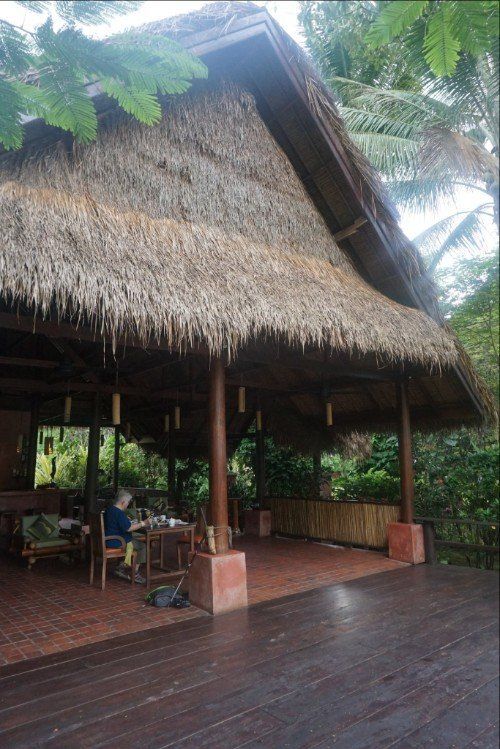Laos
Laotian Mountain Tribes
Tucked into mountain nooks all over Laos are small villages of mountain people. Although they represent dozens of tribes, we had the fortune of visiting just three: Akha, Hmong, and Khmu, each with a very unique history:
- The Akha migrated from Tibet in the 16th and 17th centuries due to persecution. Today, there are 59,000 Akha living in Laos (1.3M still live in China)
- The Hmong migrated from China in the 18th and 19th centuries due to persecution by Imperial China. They lived peacefullly in Laos until the 1960's. At that time, they numbered 300,000. During the Vietnam War, 25% of all Hmong males in Laos died in combat fighting for the United States against the north. After the American withdrawal, Hmong who were persecuted by the Lao government for siding with the Americans, many thousands were killed in the Hmong genocide, and 130,000 subsequently fled to America. Today, 600,000 Hmong live in Laos, with around 4,000 living in the jungles (4-15M exist worldwide). The systematic ethnic cleansing of Lao Hmong continues to this day.
- The Khmu are among the original inhabitants of Laos and have been resident here since at least the 13th century after migrating from Southern China. As has been the case with original inhabitants of North America and Australia, the Khmu have suffered from intense discrimination, persecution, and systematic destruction from later colonizers. Today, 700,000 live in Laos, with only 100,000 living outside of Laos.
We were staying at the Muang La Lodge (www.muangla.com) for 3 nights, and the accommodations included daily excursions. One of those excursions was a day-long 4 wheel drive visit to remote tribal villages. The lodge has just ten rooms, all air-conditioned and very well-appointed (only one other guest was present while we stayed there).
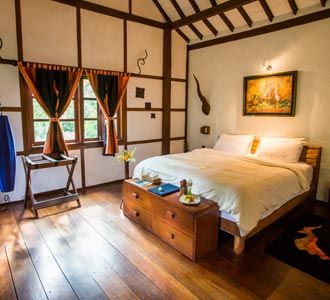
Breakfast and dinner are included; lunch is available at an extra charge. Meals were five-star, comparable to the best restaurants we have eaten at anywhere in the World, combining local flavors with French flair, beautifully presented. Here is view of the outdoor dining area.
The Akha village we visited had a population of 750. As in the case of all three tribes, the Akha are subsistence farmers (in this case, corn, dry-land rice, and poppies). They clear cut an area of forest within walking distance of their village, cultivate that land for a few years, and then repeat the process on another section of forest. They speak a Tibetan-Burmese language; we did not attempt to communicate with them except with exchanged smiles. Akha villages are "guarded" by village gates, which separate the human world (the village) from the spirit world (outside the village).
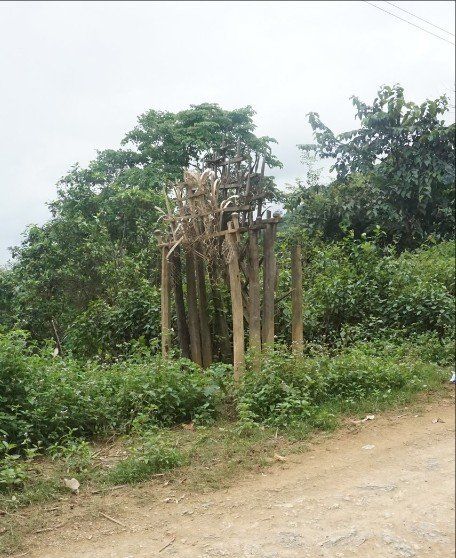
The West categorizes Akha religion as "animist;" they make offerings to mountains, rivers, trees, animals, rice, ancestors, and heaven. They believe that the Earth was created by a female called Aoma. Once inside the village, we were forbidden from taking photographs; as in the case of many cultures, the villagers may consider photographs to be soul theft.
The Hmong village had a population of just 450. We were allowed to take photographs. Here are 2 photos of a villager weaving a new wall for his home out of bamboo. In the background you can see what a finished wall on a house looks like.
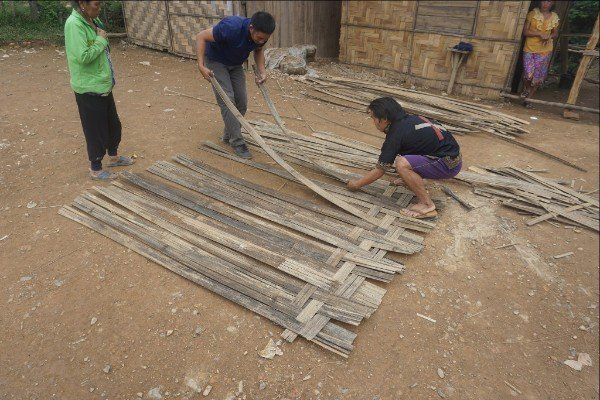
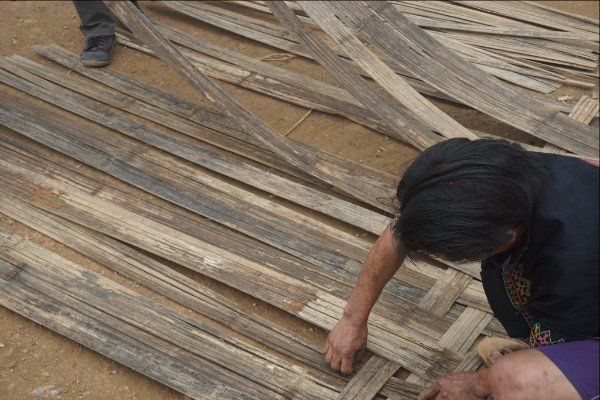
The one-story homes are constructed with a grass roof sloping almost to the ground on one side. The Hmong's principal crop is rice, although they also grow corn, sweet potatoes, yams, taro, and cabbage, all for family or village use. The only cash crop is opium poppy. When we visited, we saw only children and their grandparents; all the parents were working in the fields. Hmong speak a language of the Miao-Yao family of languages.
Hmong practice ancestral worship as well as devotion to nature. The shaman is the intermediary between the human and spiritual worlds. Like in the case of Navajo medicine men, the shaman inherits his or her powers from parents or grandparents who were shamans.
We did not interact at all with the villagers; we just observed them from afar. For another Westerner's perspective of a much closer upfront personal encounter with the Hmong, check out http://waysofwanderers.com/the-kindness-of-strangers-visiting-a-hmong-village/.
Our last visit was to the Khmu village of 225 inhabitants. Their primary crop is rice; they also hunt and gather fruit from the forest. We stopped to visit with a group of children and their grandmother. We had hoped to talk with them but our guide assured us that communication would be difficult; they speak Lao and Khmu, related to Khmer and Vietnamese, and no English.
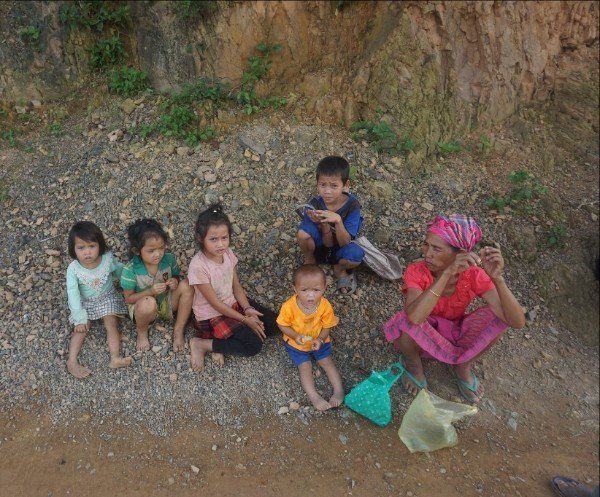
The mother of one of the children soon joined us with a baby. We asked her old she was (through the guide as translator). She was 19 and had two children: 5 years old and 1 year old. With a little calculation, we determined that she gave birth to her first child at 14 and that means she conceived at 13. My guess is that the Khmu women (girls) have been marrying and bearing children at the age of puberty forever. I have been unable to find out the average life expectancy of the Khmu, but I have learned that only 4-6% of the Khmu population is over 55 years old (from Social Structures and Aging Individuals: Continuing Challenges, edited by K. Schaie and R. Abeles, Springer, 2008, page 297). I would estimate a Khmu woman's life expectancy is probably around 48. I'm not justifying child marriage; I'm just explaining one possible motivation.
Most Khmu rice farmers have replaced their buffaloes with simple tractors called Chinese buffaloes. These diesel-powered, hand-operated machines have high treads that enable them to stay high and dry even in knee-deep rice paddies.
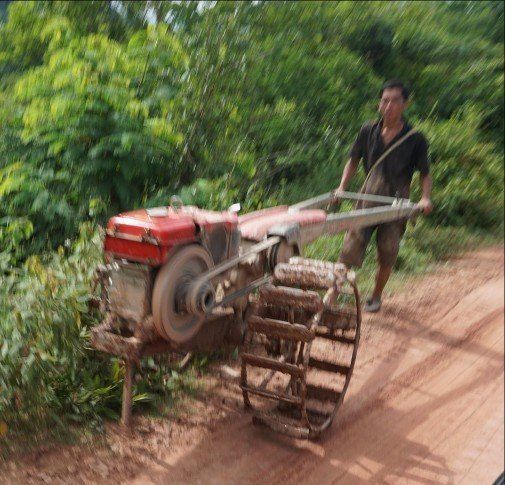
As we were leaving the Khmu village in pouring rain, we stopped at a high school teacher's house and asked if we could enjoy our picnic lunch on his porch out of the rain; he agreed. During lunch, we learned a bit about his life. As a high school teacher, he is one the highest paid members of the community. He earns 2,000,000 Kip/month (US$3,000/year).
On our last evening in Laos, we were invited to be guests at a Baci ceremony at a nearby Khmu home. Around a dozen neighbors had gathered to wish us safe travels. We sat around an elaborate arrangement called a pha kwan. It consisted of fresh flowers, food, and strings atop a small white tablecloth.
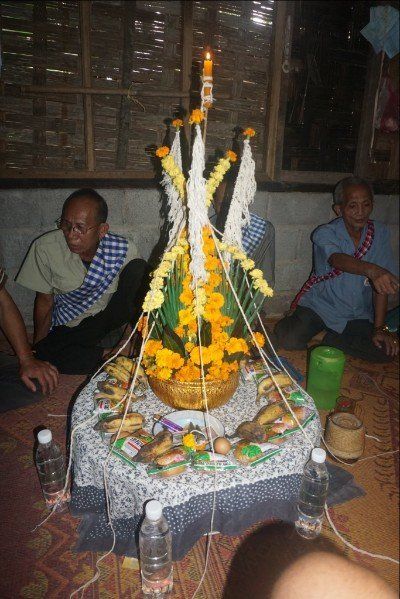
The leader then chanted 15 minutes of Buddhist prayers. Then, using a stick dipped in homemade rice whiskey (aka moonshine), the leader brushed our upturned palms 35 times from our wrists to fingertips, to send away 35 bad spirits, or kwan. Then using the same moonshine-dipped stick, he sent 35 good kwan into our bodies by brushing from our fingertips to our wrists. Following this, while the leader chanted, all participants took turns tying cotton strings around our wrists to hold those good kwan in.

Then we drank the rice whiskey from straws (see above), followed by many shots of another kind of moonshine. AT the end of the ceremony, we all enjoyed the food that had been part of the arrangement: eggs, fruit, and so on.
We departed Laos from the Luang Prabang airport, a 5-hour ride from Muang La. The scenery along the way was spectacular. One area just south of of the village of Houay Leuang looked just like Three Gorges in China. ANd then, much to my surprise, right in the middle of the gorges, appeared a huge PowerChina hydroelectric dam under construction. It reminded me of how wide China's footprint is throughout Southeast Asia, Africa, and South America.
© Alan M. Davis
If you enjoyed this story, consider buying my book,
Unusual Asia: Traveling on the Edge. It contains eleven other stories of our adventures in Asia.
Contact Him
To contact him at Offtoa:
email: adavis(at)offtoa.com
phone: 719-232-1938 (cell), 719-425-8858 (office)
To contact him for other reasons:
email: aldavis171(at)gmail.com
phone: 719-232-1938 (cell)
